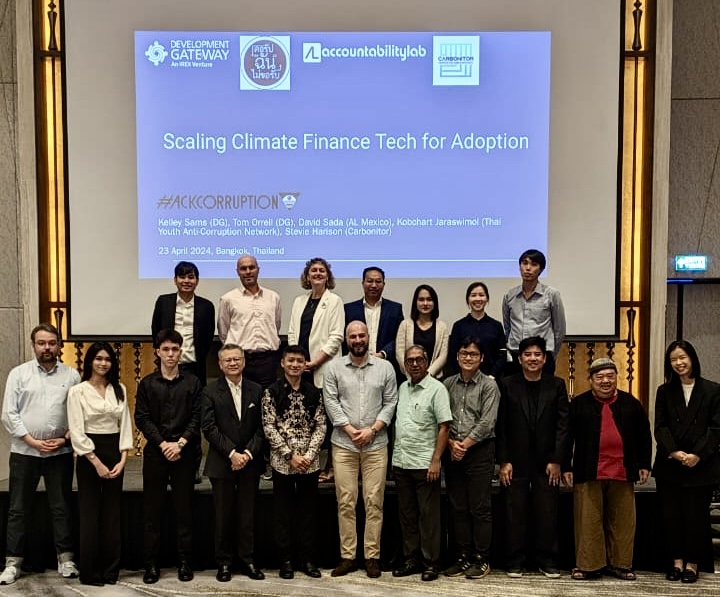
Letting the Sunshine in: Building Inclusive, Accountable, and Equitable Climate Finance Ecosystems
In late April 2024, Development Gateway: An IREX Venture, together with the Thai Youth Anti-Corruption Network, organized an invite-only roundtable in Bangkok, Thailand to discuss how to efficiently and effectively use climate financing, which is money committed for activities to mitigate or adapt to the impacts of climate change.
Participants of the roundtable, hosted by the HackCorruption project led by Accountability Lab, came from a broad range of local, regional, and global civil society organizations; media; and private sector, academic, and development partner organizations. Together, we explored the concept and current execution of climate financing strategies. How do we define, access, monitor, and assess the impact of these financial flows?
Ultimately, the group determined that ensuring funds allocated to curb the negative impacts of climate change have the greatest impact requires a multi-disciplinary and multi-stakeholder approach that prioritizes local contexts, inclusive governance, transparency, accountability, and equitable distribution of resources.
Disparate but Necessary Efforts: The Current State of Climate Financing
The current state of climate financing—in short—is a mess.
At COP28 in 2023, climate finance was at the forefront. Several member states, notably developing countries, highlighted the need to lean into climate finance transparency and develop rigorous national climate finance tracking frameworks. Public, private, and blended funding and financing mechanisms are proliferating around the globe in a sea of market and regulatory experimentation. From carbon taxes, trading, and capture schemes to direct subsidies, governments and international organizations are simultaneously pursuing multiple (sometimes untested) funding and financing approaches.
While these necessary but disparate efforts continue to evolve, fundamental questions about climate finance remain unanswered. For instance, what investments constitute climate investments? How do we track financial flows and market activity while avoiding double counting investments? How do we ensure that investments in certain climate mitigation strategies are not harming the people living in areas that it is intended to help? The absence of agreed global standards and classifications regarding this cornerstone issue makes it challenging to track and measure what types of initiatives provide the greatest return on investment and positive environmental impact.
Additionally, a shared understanding of how climate investments are monitored and how impacts are tracked is critical to understand progress toward the legally binding commitment UN Member States made at the Conference of the Parties to the UN Climate Change Conference in 2015 (COP21 Paris) to hold “the increase in the global average temperature to well below 2o C above pre-industrial levels [and aim] to limit the temperature increase to 1.5 o C above pre-industrial levels.”
The cost of meeting this commitment is astronomical. The Climate Policy Initiative’s most recent estimates for meeting the Paris Agreement, “range from USD 5.4 trillion to USD 11.7 trillion per year until 2030, and between USD 9.3 trillion and USD 12.2 trillion per year over the following two decades.” This comprises funds allocated for the transformation of energy systems, restoring and protecting natural resources as well as methane abatement, increased resilience, and coping with damage.
The 100 trillion-dollar question: how do we ensure good governance of climate finance mechanisms and data flows?
Shining light on climate finance and ensuring that it is used for positive change requires inclusive, accountable, and equitable systems. In the absence of clear global standards of how climate finance can be used to create positive social and environmental impacts, the priorities and needs of local contexts must take precedence to ensure that investments achieve desired impact and that solutions are locally owned as well as locally beneficial. Discussions with representatives of civil society organizations in Thailand highlighted the uneven and messy execution that can occur with climate projects aimed at outcomes aligned with donor priorities that are sometimes in opposition with those of communities.
Given the vastness of climate change challenges that the world faces—touching on all aspects of natural, social, economic, political, and cultural life, the identification and articulation of local priorities must happen through both multi-disciplinary and multi-stakeholder processes that account for this all-encompassing scope and effectively contextualize local priorities and interventions. Without the serious engagement of local communities (e.g., smallholder farmers, indigenous and pastoralist groups, and other local land stewards) in carbon offset plans, things can quickly go wrong; for instance, planting monoculture forests that do more harm than good. Roundtable participants described how farmers and rural residents could collaborate with agricultural professionals and local industry to propose changes that were the most beneficial and least harmful to all.
In the absence of clearly articulated definitions of what counts as “climate finance,” the opportunities for double-counting, misappropriation, or embezzlement of money are significant. Given the enormity of the sums involved in servicing climate change adaptation and mitigation needs, open government principles of transparency, inclusive governance, and accountability are especially important. Regulation of new carbon markets will only succeed if founded in these principles, which function to both establish a predictable and certain regulatory environment as well as act as a brake and series of checks and balances on the potential misappropriation of funds.
Finally, the equitable distribution of the risks and benefits of climate financing mechanisms must be taken seriously and baked into climate finance discourse. Market-oriented mechanisms such as carbon trading schemes are currently geared at incentivizing transnational corporations to reduce their carbon footprints by placing a price on carbon emissions. However, extrapolating the model to a global level where companies in rich countries are able to offset their emissions through interventions in poorer countries significantly raises the risk of inequitable outcomes in the market.
Moving forward, Development Gateway: An IREX Venture plans to build on the lessons learned in Bangkok. In particular, our focus will be on the role and function that open-source digital public goods and civic technology can play in supporting the co-design, building, and scaling of inclusive, accountable, and equitable climate finance ecosystems. We are particularly interested in how civic technology can be co-created with youth stakeholders so that it can be tailored to the particular needs and priorities of young adults for ensuring greater transparency.
Share
Recent Posts

Why Africa Will Define the Next Decade of Digital Public Infrastructure
As the global conversation shifts from frameworks to delivery, this blog reflects on why Africa will define the next decade of Digital Public Infrastructure (DPI), drawing on insights from the Global DPI Summit and years of on-the-ground experience.

Building Useful & Usable AI: A New Tool to Curb Procurement Corruption
DG, together with Accountability Lab, have launched a new AI-powered contract summary and analysis tool through the HackCorruption program, designed to help journalists, civil society, and the private sector detect red flags in procurement processes.

Accelerating Institutions: How DG’s 25 Years Create Unique Value for AI
As AI reshapes the digital landscape, we share in this blog DG’s approach to helping institutions adopt it effectively using clear use cases, strong data foundations, and decades of experience to cut through hype and prioritize ethical, sustainable impact.